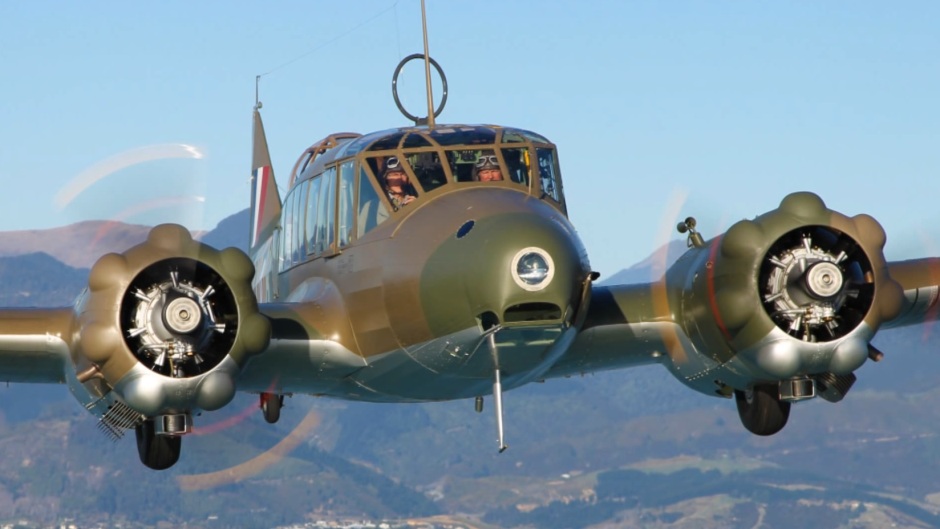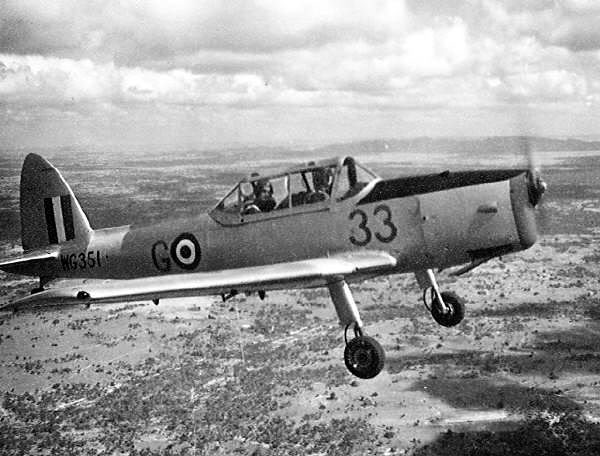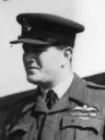Aircraft Flown 1947-55

Avro Anson Mk1

Anson Xll with Cheetah XV Engines – Internal Flights in Argentina. Reg No. PH617
Frequent internal UK Flights including 2 Air Searches for missing Stardust Lancastrian of BSAAC. A distinctive feature of the Anson I was its landing gear retraction mechanism which required no fewer than 140 turns of the hand crank by the Pilot. To forgo this laborious process, early model Aircraft often made short Flights with the landing gear extended at the expense of 30mph (50km/h) of cruising speed. The Aircraft’s true role, however, was to Train Pilots for flying multi-Engined Bombers such as the Avro Lancaster. The Anson was also used to train the other members of a Bomber’s Aircrew, such as Navigators, Wireless Operators, Bomb Aimers and Air Gunners. Postwar, the Anson continued in the training and light transport roles. Avro Anson

Avro Anson Diagrams

Chipmunk – Gypsy Major Engine Reg No.887
The de Havilland Canada DHC-1 Chipmunk is a Tandem, 2-seat, Single-Engined Primary Trainer Aircraft which was the standard Primary Trainer for the RAF and several other Air Forces through much of the post-WW2 years. The de Havilland Chipmunk was the 1st Postwar Aviation Project of de Havilland Canada. The ‘Chippie’ was a favourite of the RAF It is said that the de Havilland DHC-1 Chipmunk looks the way an Airplane should look. Designed as a Military Trainer, the “Chippie” has a Tapered Wing and a narrow, sleek Fuselage that give it the appearance of a petite WW2 Fighter.

Gloster Meteor Vll and Vlll with Derwent Jet Engine
 The Gloster Meteor was the 1st British Jet Fighter and the Allies’ only operational Jet Aircraft during WW2. The Meteor’s development was heavily reliant on its ground-breaking Turbojet Engines, pioneered by Sir Frank Whittle & his Company, Power Jets Ltd. Development of the Aircraft itself began in 1940, although work on the Engines had been underway since 1936. Nicknamed the “Meatbox“, the Meteor was not a sophisticated Aircraft in its Aerodynamics but proved to be a successful Combat Fighter. The Derwent Engine was installed on many of the later Production Meteors, the adoption of this new power plant led to considerable performance increases.
The Gloster Meteor was the 1st British Jet Fighter and the Allies’ only operational Jet Aircraft during WW2. The Meteor’s development was heavily reliant on its ground-breaking Turbojet Engines, pioneered by Sir Frank Whittle & his Company, Power Jets Ltd. Development of the Aircraft itself began in 1940, although work on the Engines had been underway since 1936. Nicknamed the “Meatbox“, the Meteor was not a sophisticated Aircraft in its Aerodynamics but proved to be a successful Combat Fighter. The Derwent Engine was installed on many of the later Production Meteors, the adoption of this new power plant led to considerable performance increases.
Flying Instructors – F/Lt Morley, F/Lt Debenham, F/S Gill
Proficiency – HB Pilot, Above Average
1st Solo Flight 10th June 1953
Fuselage Codes Unknown – Reg No.s 942, 405, 318, 947,248, 119,
No.3 Group Flying College RAF Manby 1955 B Flight
All Weather Jet Refresher Course
405, WH218, WL481, WH112, WH235, WE931, WH737, WA707, 711, 405,415, WA840, VZ445, WL367,
English Electric Canberra T-MK4
In June 1945, the Aircraft that was to become the Canberra bore many similarities to the eventual design, despite the placement of a single, centrally-mounted Turbojet Engine; 2 Wing-mounted Engines were adopted later that year. On 7th January 1946, the Ministry of Supply placed a contract for the development & production of 4 English Electric A.1 Aircraft. It continued to be known as the English Electric A.1 until it was given the name Canberra after the Capital of Australia in January 1950 by Sir George Nelson, Chairman of English Electric, as Australia was the Aircraft’s 1st Export Customer. Although Jet-powered, the Canberra design philosophy was very much in the Mosquito mould, providing room for a substantial Bomb Load, fitting 2 of the most powerful Engines available, and wrapping it in the most Compact & Aerodynamic package possible. Rather than devote Space & Weight to Defensive Armament which historically could not overcome Fighter Aircraft, the Canberra was designed to fly fast & high enough to avoid air-to-air Combat entirely
Flying Instructors – P/O Price, F/Lt Cottle, F/Lt Wainwright
Proficiency – Average
1st Solo Flight 10th June 1953
Fuselage Codes Unknown – Reg No.s 843, 844, 847
Vulcan To The Sky Trust is expanding its horizons with inspirational work to demonstrate Engineering excellence in early generation Jet-engine Aircraft with the planned restoration of Canberra WK163.
Avro Vulcan – Prototype 777 – Sapphire 6 Engine –
1st Pilot S/L Wales 2nd Pilot W/C A J L Craig
18th Jan 1954 RAF Waddington
Armstrong Siddeley Sapphire 4 x ASSa.6 Engines of 7,500 lbf (33 kN) Thrust
 The 2nd prototype, VX777, flew in September 1953. More representative of Production Aircraft, it was lengthened to accommodate a longer Nose undercarriage leg, featured a visual Bomb-aiming blister under the Cabin and was fitted with Bristol Olympus 100 Engines of 9,750ft/lb (43.4 kN) thrust. At Falk’s suggestion, a Fighter-style control stick replaced the Control Wheel. Both Prototypes had almost pure Delta Wings with Straight leading edges. During Trials in July 1954, VX777 was substantially damaged in a heavy landing at Farnborough. It was repaired and fitted with Olympus 101 Engines of 11,000 ft/lb (49 kN) Thrust before resuming Trials in October 1955. While exploring the high speed & high Altitude Flight envelope, mild buffeting and other undesirable flight characteristics were experienced while approaching the Speed of Sound, including an alarming tendency to enter an uncontrollable Dive, unacceptable to the Aeroplane & Armament Experimental Establishment (A&AEE) at Boscombe Down. The solution included the “Phase 2” Wing, featuring a ‘kinked & drooped leading edge’ and Vortex Generators on the Upper Surface, 1st Tested on 707A WD480. An auto-Mach Trimmer introduced a Nose-up attitude when at high Speeds, the Control Column had to be pushed rather than pulled to maintain level Flight.
The 2nd prototype, VX777, flew in September 1953. More representative of Production Aircraft, it was lengthened to accommodate a longer Nose undercarriage leg, featured a visual Bomb-aiming blister under the Cabin and was fitted with Bristol Olympus 100 Engines of 9,750ft/lb (43.4 kN) thrust. At Falk’s suggestion, a Fighter-style control stick replaced the Control Wheel. Both Prototypes had almost pure Delta Wings with Straight leading edges. During Trials in July 1954, VX777 was substantially damaged in a heavy landing at Farnborough. It was repaired and fitted with Olympus 101 Engines of 11,000 ft/lb (49 kN) Thrust before resuming Trials in October 1955. While exploring the high speed & high Altitude Flight envelope, mild buffeting and other undesirable flight characteristics were experienced while approaching the Speed of Sound, including an alarming tendency to enter an uncontrollable Dive, unacceptable to the Aeroplane & Armament Experimental Establishment (A&AEE) at Boscombe Down. The solution included the “Phase 2” Wing, featuring a ‘kinked & drooped leading edge’ and Vortex Generators on the Upper Surface, 1st Tested on 707A WD480. An auto-Mach Trimmer introduced a Nose-up attitude when at high Speeds, the Control Column had to be pushed rather than pulled to maintain level Flight.
 Avro Vulcan XH558
Avro Vulcan XH558
The Spirit Of Great Britain was the last remaining Airworthy example of the 134 Avro Vulcan jet-powered Delta winged Strategic Nuclear Bomber Aircraft operated by the RAF during the Cold War. It was the last Vulcan in Military Service, and the last to fly at all after 1986. It last flew on 28th October 2015. With XH558 now permanently grounded, the Trust intends to remain at Doncaster Sheffield Airport, and make the Vulcan the focus of a new Educational & Heritage facility. The Avro Vulcan is an iconic example of British Aerospace Engineering at its world-beating best. Its impressive list of Technical achievements includes being the 1st successful large Delta Wing Aircraft, leading directly to Concorde and the Space Shuttle, and delivering performance and agility so close to a Jet Fighter’s that it was given a Fighter-style Control Column in place of the traditional Bomber Pilot’s Yoke. That agility allowed XH558 to deliver amazing Air Displays, which unfortunately finished in 2015, but there are great Plans to use her as an inspirational centrepiece in a future ETNA Centre. This is in part due to the Trust’s ongoing commitment to keep XH558 in good condition and use it for educational purposes, which they committed to do for 80 years as a condition of Lottery funding. The 1st Stage is to establish the Vulcan Aviation Academy & Heritage Centre. This will feature an Academy building for 14/18-year-olds, which will focus on “6 areas of Aviation skills: piloting, air traffic controls, airport ground operations, aircraft operations, cabin crew & aviation engineering”. XH558 will be housed in an adjacent Heritage Centre, where it will be maintained so as to be able to perform regular fast taxi runs, the frequency of which would be funding dependent. With less Engineering required to support the Vulcan as a taxi-able Exhibit, the Trust’s associated Engineering Company was examining the possibility of setting up as an independent, CAA-approved, Heritage Aviation Servicing operation.
Pathfinder Wing Commander Alan John Laird Craig DSO, MBE, DFC, AFC has a Commemorative Plaque under G-VLCN Avro Vulcan XH558’s Wing
Vulcan To The Sky Trust
Unit 12, Dunns Close, Caldwell Road, Nuneaton, Warwickshire CV11 4NF
Hastings H259 –15th October 1954 Booker to Defford

The Handley Page HP.67 Hastings was a British Troop-carrier & Freight Transport Aircraft designed and built by Handley Page Aircraft Company for the RAF. At the time, it was the largest Transport plane ever designed for the RAF, and it replaced the Avro York as the standard long-range Transport.
de Havilland DH.104 Devon C.2 Transport Aircraft
15th October 1954 Booker to Basingbourne (Return)

The WW2 Brabazon Committee report had called for a British short-haul Aircraft to be designed for use after the cease of hostilities, the DH.104 Dove was the de Havilland solution. Design work began on the Dove began towards the end of the War, with the 1st of 2 Prototypes flying at Hatfield Airfield, Hertfordshire in September 1945. The de Havilland DH.104 Dove‘s and Devon‘s (transport & communications version) were the 1st British Transport Aircraft to have Tricycle Landing Gear & Reversible Pitch propellers a total 528 DH.104’s had been made when in 1967 production ended, 328 Civilian Doves, 127 Military Devon C.2s and 13 Sea Devon’s
Retirement
Squadron Leader A J L Craig DSO, MBE, DFC, AFC (103561) (at own request after 16 years in the RAF), Retaining the rank of Wing Commander, 11th Apr. 1956 aged 33. The same year the Lancaster Bomber his main Work-Horse was retired by the RAF.


